Question 1.
Find the degree of each of the polynomials given below,
i) x5- x4+ 3
Solution:
Degree is 5.
ii) x2+ x - 5
Solution:
Degree is 2.
iii) 5
Solution:
Degree is 0.
iv) 3x6+ 6y3 - 7
Solution:
Degree is 6.
v) 4 - y2
Solution:
Degree is 2.
vi) 5t - √3
Solution:
Degree is 1.
Question 2.
Which of the following expressions are polynomials in one variable and which are not ? Give reasons for your answer.
i) 3x2 - 2x + 5
Solution:
Given expression is a polynomial in one variable.
ii) x2+ √2
Solution:
Given expression is a polynomial in one variable.
iii) p2- 3p + q
Solution:
Given expression is not a polynomial in one variable. It involves two variables p and q.
iv) y + 2/y
Solution:
Given expression is not a polynomial. Since the second term contains the variable in its denominator.
v)5√x + x√5
Solution:
Given expression is not a polynomial. Since the first term’s exponent is not an integer.
vi) x100 + y100
Solution:
Given expression has two variables. So it is not a polynomial in one variable.
Question 3.
Write the coefficient of x3in each of the following.
i) x3 + x + 1
ii) 2 - x3+ x2
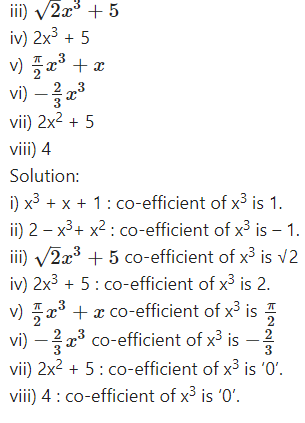
Question 4.
Classify the following as linear, quadratic and cubic polynomials.
- i) 5x2+ x - 7 : degree 2 hence quadratic polynomial.
- ii) x - x3, : degree 3 hence cubic polynomial.
- iii) x2+ x + 4 : degree 2 hence quadratic polynomial.
- iv) x - 1 : degree 1 hence linear polynomial.
- v) 3p : degree 1 hence linear polynomial.
- vi) πr2: degree 2 hence quadratic polynomial.
Question 5.
Write whether the following statements are True or False. Justify your answer.
- i) A binomial can have at the most two terms
- ii) Every polynomial is a binomial
- iii) A binomial may have degree 3
- iv) Degree of zero polynomial is zero
- v) The degree of x2+ 2xy + y2is 2
- vi) πr2 is monomial
Solution :
- i) A binomial can have at the most two terms -True
- ii) Every polynomial is a binomial - False
- [∵ A polynomial can have more than two terms]
- iii) A binomial may have degree 3 - True
- iv) Degree of zero polynomial is zero - False
- v) The degree of x2+ 2xy + y2 is 2 - True
- vi) πr2is monomial - True
Question 6.
Give one example each of a monomial and trinomial of degree 10.
Solution :
- 7x10 is a monomial of degree 10.
3x2y8 + 7xy - 8 is a trinomial of degree 10.
Question 1.
Find the value of the polynomial 4x2- 5x + 3, when
(i) x = 0
Solution:
The value at x = 0 is
4(0)2- 5(0) + 3
= 3
(ii) x = -1
Solution:
The value at x = -1 is
4 (- 1)2 - 5 (- 1) + 3
= 4 + 5 + 3
= 12
iii) x = 2
Solution:
The value at x = 2 is
4(2)2- 5(2) + 3
= 16 -10 + 3
= 9
iv) x = 1/2
Solution:
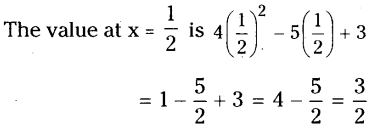
Question 2.
Find p(0), p(1) and p(2) for each of the following polynomials.
i) p(x) = x2- x + 1
Solution:
p(0) = 02- 0 + 1 = 1
p(1) = 12- 1 + 1 = 1
p(2) = 22- 2 + 1 = 3
ii) P(y) = 2 + y + 2y2- y3
Solution:
p(0) = 2 + 0 + 2(0)2- 03= 2
p(1) = 2+ 1 + 2(1)2- 13= 4
p(2) = 2 + 2 + 2(2)2-23= 4 + 8- 8 = 4
iii) P(z) = z3
Solution:
p(0) = 03= 0
p(1) = 13= 1
p(2) = 23= 8
iv) p(t) = (t – 1)(t + 1) = t2 - 1
Solution:
p(0) = (0 - 1) (0 + 1) = - 1
p(1) = t2- 1 = 12 - 1 = 0
p(2) = 22- 1 = 4 - 1 = 3
v) p(x) = x2 - 3x + 2
Solution:
p(0) = 02- 3(0) + 2 = 2
p(1) = 12- 3(1) + 2 = 1 - 3 + 2 = 0
p(2) = 22- 3(2) + 2 = 4- 6 + 2 = 0
Question 3.
Verify whether the values of x given in each case are the zeroes of the polynomial or not ?
i) p(x) = 2x + 1; x = -1/2
Solution:
The value of p(x) at x = -1/2 is
p(-1/2)=2(-1/2)+1
= -1 + 1 = 0
∴ x = -1/2 is a zero of p(x).
(ii) p(x) = 5x - π ; x = ?3/2
Solution:
The value of p(x) at x = ?3/2 is
p(?3/2)=5(?3/2)?π=?15/2?π≠0
∴ x = ?3/2 is not a zero of p(x).
iii) p(x) = x2 - 1; x = ±1
Solution:
The value of p(x) at x = 1 and - 1 is
p(1) = 12 - 1 = 0
p(-1) = (-1)2 -1 = 0
∴ x = ±1 is a zero of p(x).
iv) p(x) = (x - 1) (x + 2); x = - 1, - 2
Solution:
The value of p(x) at x = - 1 is
p(-1) = (-1 - 1) (-1 + 2)
=-2 x 1 =-2 ≠ 0
Hence x = - 1 is not a zero of p(x).
And the value of p(x) at x = - 2 is
p (- 2) = (- 2 - 1) (- 2 + 2) = - 3 x 0 = 0
Hence, x = - 2 is a zero of p(x).
v) p(y) = y2; y = o
Solution:
The value of p(y) at y = 0 is p(0) = 02 = 0
Hence y = 0 is a zero of p(y).
vi) p(x) = ax + b ; x = ?b/a
Solution:
The value of p(x) at x = ?ba is
p(?b/a)=a(?b/a)+b
= -b + b = 0
∴ x = ?ba is a zero of p(x).
vii) f(x) = 3x2 - 1; x = ?1/√3, 2/√3
Solution:
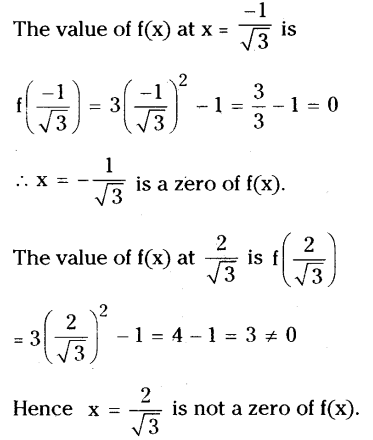
viii) f(x) = 2x - 1; x = 1/2; ?1/2
Solution:
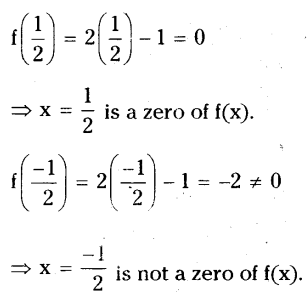
Question 4.
Find the zero of the polynomial in each of the following cases.
i) f(x) = x + 2
Solution:
x + 2 = 0
x = - 2
ii) f(x) = x - 2
Solution:
x - 2 = 0
x = 2
iii) f(x) = 2x + 3
Solution:
2x + 3 = 0
2x = - 3
x = ?3/2
iv) f(x) = 2x - 3
Solution:
2x - 3 = 0
2x = 3
x = 3/2
v) f(x) = x2
Solution:
x2 = 0
x = 0
vi) f(x) = px, p ≠ 0
Solutin:
px = 0
x = 0
vii) f(x) = px + q; p ≠ 0; p, q are real numbers.
Solution:
px + q = 0
px = -q
x = ?q/p
Question 5.
If 2 is a zero of the polynomial p(x) = 2x2- 3x + 7a, find the value of
a
Solution:
Given that 2 is a zero of p(x) = 2x2- 3x + 7a
(i.e.) p(2) = 0
⇒ 2(2)2- 3(2) + 7a = 0
⇒ 8 - 6 + 7a = 0
⇒ 2 + 7a = 0
⇒ 7a = -2
⇒ a =-2/7
Question 6.
If 0 and 1 are the zeroes of the polynomial f(x) = 2x3 – 3x2 + ax + b, find the values of a and b.
Solution:
Given that f(0) = 0; f(1) = 0 and
f(x) = 2x3- 3x2+ ax + b
∴ f(0) = 2(0)3- 3(0)2+ a(0) + b
⇒ 0 = b
Also f(1) = 0
⇒ 2(1)3- 3(1)2+ a(1) + 0 = 0
⇒ 2 - 3 + a = 0 .
⇒ a = 1
Hence a = 1; b = 0
Question 1.
Find the remainder when
x3+ 3x2+ 3x + 1 is divided by the following Linear polynomials i) x + 1 Each
Solution:
Let f(x) = x3+ 3x2+ 3x + 1
By remainder theorem, the remainder is f (- 1)
f (- 1) = (- 1)3+ 3(- 1)2+ 3(- 1) + 1
= - 1 + 3 - 3 + 1 = 0
ii) x ? 1/2
f(x) = x3 + 3x2 + 3x + 1
By remainder theorem, the remainder is f(1/2)
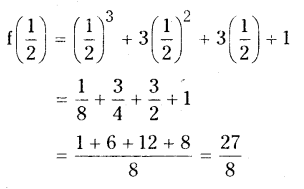
iii) x
Solution:
f(x) = x3+ 3x2+ 3x + 1
The remainder is f(0)
∴ f(0) = 03+ 3(0)2+ 3(0) + 1 = 1
iv) x + π
Solution:
f(x) = x3+ 3x2+ 3x + 1
By remainder theorem, the remainder is f(- π)
f(- π) = (- π)3 + 3(-π)2+ 3 (-π) + 1 .
= π3+ 3π2- 3π + 1
v) 5 + 2x
f(x) = x3+ 3x2+ 3x + 1
The remainder is f(-5/2)
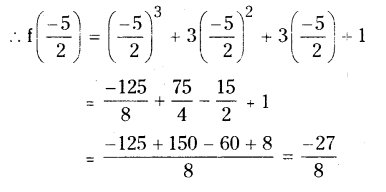
Question 2.
Find the remainder when x3- px2+ 6x - p is divided by x - p.
Solution:
Let f(x) = x3- px2+ 6x - p
(x - a) = x - p)
By Remainder theorem, the remainder is f(p)
∴ f(P) = P3- P(P)2+ 6p - p
= p3- p3+ 5p = 5p
Question 3.
Find the remainder when 2x2- 3x + 5 is divided by 2x - 3. Does it exactly divide the polynomial ? State reason.
Solution:
Let f(x) = 2x2- 3x + 5 and
x - a = 2x - 3 = x - 3/2
By Remainder theorem f(x) when divided by (x - 3/2) leaves a remainder f(3/2)
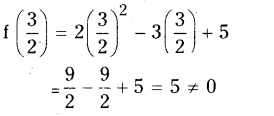
As the remainder is 5 we say that (2x - 3) is not a factor of f(x).
Question 4.
Find the remainder when 9x3- 3x2+ x - 5 is divided by x - 2/3
Solution:
Let f(x) = 9x3- 3x2+ x - 5
x-a = x - 2/3
Remainder theorem the remainder is f(2/3)
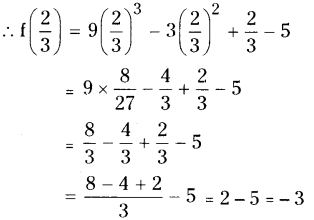
Question 5.
If the polynomials 2x3+ ax2+ 3x - 5 and x3+ x2 – 4x + a leave the same remainder, when divided by x - 2, find the value of a.
Solution:
Let f(x) = 2x3+ ax2+ 3x - 5
g(x) = x3 + x2- 4x + a
Given that f(x) and g(x) divided x - 2
give same remainder.
i e., f(2) = g(2)
By Remainder theorem.
But f(2) = 2(2)3 + a(2)2 + 3(2) - 5
= 2 x 8 + 4a + 6 - 5
= 17 +4a
g(2) = 23+ 22- 4(2) + a .
= 8 + 4 - 8 + a = 4 + a
i.e., 4 + a = 17 + 4a
∴ a - 4a = 17 - 4
– 3a = 13
a = -13/3
Question 6.
If the polynomials x3+ ax2+ 5 and x3- 2x2+ a are divided by (x + 2) leave the same remainder, find the value of a.
Solution:
Let f(x) = x3+ ax2+ 5
g(x) = x3- 2x2+ a
Given that when f(x) and g(x) divided by (x + 2) leaves the same remainder.
i.e.,f(-2) = g(-2)
By Remainder theorem
f(- 2) = (- 2)3+ a(- 2)2+ 5
= -8 + 4a + 5 = 4a - 3
g(- 2) = (- 2)3- 2(- 2)2+ a
= -8 - 8 + a = a - 16
By problem,
4a - 3 = a - 16
4a - a = - 16 + 3
⇒ 3a = - 13 ⇒ a = -13/3
Question 7.
Find the remainder when f(x) = x4- 3x2+ 4 is divided by g(x) = x - 2 and verify the result by actual division.
Solution:
Given f(x) = x4 - 3x2+ 4
g(x) = x - 2
The remainder when f(x) is divided by g(x) is f(2).
f(2) = 24 - 3(2)2 + 4
= 16 - 12 + 4
= 8
Actual division
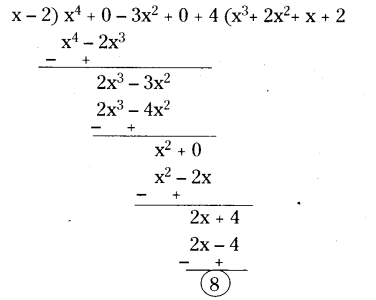
∴ The remainder either by Remainder theorem or by actual division is the same.
Question 8.
Find the remainder when p(x) = x3- 6x2+ 14x - 3 is divided by g(x) = 1 - 2x and verify the result by long division method.
Solution:
Given p(x) = x3 - 6x2+ 14x - 3
g(x) = 1 - 2x
By Remainder theorem when p(x) is divided by g(x) is p(1/2).
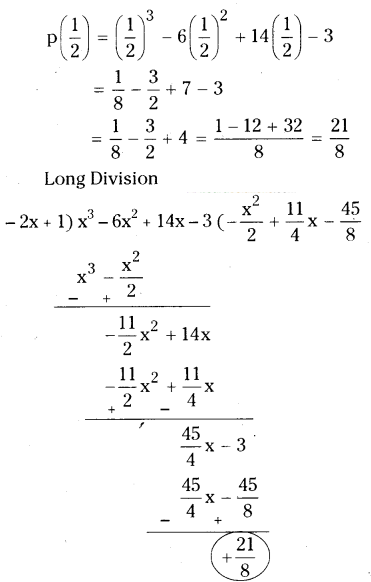
Question 9.
When a polynomial 2x3+ 3x2+ ax + b is divided by (x - 2) leaves remainder 2, and (x + 2) leaves remainder 2. Find a and b.
Solution:
Let f(x) = 2x3+ 3x2+ ax + b
The remainder when f(x) is divided by (x - 2) is 2.
i.e., f(2) = 2
⇒ 2(2)3+ 3(2)2+ a(2) + b = 2
⇒ 16 + 12 + 2a +b = 2
⇒ 2a + b = -26 …………………..(1)
Also the remainder when f(x) is divided by (x + 2) is – 2.
i.e., f(- 2) = - 2
⇒ 2(- 2)3+ 3(- 2)2+ a (- 2) + b = -2
⇒ -16 + 12 - 2a + b = -2
– 2a + b = 2 ………………..(2)
Solving (1) and (2),

b = - 12
and 2a - 12 = - 26
2a = -26+ 12
a = -14/2 = -7,
a = -7, b = - 12
Question 1.
Determine which of the following polynomials has (x + 1) as a factor.
i) x3- x2- x + 1
Solution:
f(- 1) = (- 1)3- (- 1)2- (- 1) + 1
= -1 - 1 + 1 + 1 = 0
∴ (x + 1) is a factor.
ii) x4-x3+x2- x + 1
Solution:
f(- 1) = (- 1)4- (- 1)3+ (- 1)2- (- 1) + 1
= 1 + 1 + 1 + 1 + 1= 5
∴ (x + 1) is not a factor.
iii) x4+ 2x3+ 2x2+ x + 1
Solution:
f(- 1) = (-1)4+ 2 (- 1)3+ 2 (- 1)2+ (-1) + 1
= 1 - 2 + 2 - 1 + 1 = 1
∴ (x + 1) is not a factor.
iv) x3- x2- (3 - π3)x + π3
Solution:
f(- 1) = (- 1)3- (- 1)2 - (3 - π3)(-1) + π3
= -1 -1 + 3 - π3 + π3 = 1
∴ (x + 1) is not a factor.
Question 2.
Use the factor theorem to determine whether g(x) is a factor of f(x) in each of the following cases:
i) f(x) = 5x3+ x2- 5x - 1; g(x) = x + 1
[Factor theorem : If f(x) is a polynomial; f(a) = 0 then (x - a) is a factor of f(x); a ∈ R]
Solution:
g(x) = x+ 1 = x- a say
∴ a = - 1
f(a) = f(- 1) = 5 (- 1)3+ (- 1)2- 5 (- 1) -1
= -5 + 1 + 5 - 1 = 0
∴ x + 1 is a factor of f(x).
ii) f(x) = x3+ 3x2+ 3x + 1; g(x) = x + 1
Solution:
g(x) = x + 1 = x - a
∴ a = - 1
f(a) = f(- 1) = (- 1)3+ 3 (- 1)2+ 3(-1) + 1
= -1 + 3 - 3 + 1 =0
∴ f(x) is a factor of g(x).
iii) f(x) = x3- 4x2+ x + 6;
g(x) = x - 2
Solution:
g(x) = x- 2 = x- a
∴ a = 2
f(a) = f(2) = 23- 4(2)2+ 2 + 6
= 8 - 16 + 2 + 6 = 0
∴ g(x) is a factor of f(x).
iv) f(x) = 3x3+ x2- 20x +12; g(x) = 3x - 2
Solution:
g(x) = 3x - 2 = x- 2/3 = x - a
∴ a = 2/3
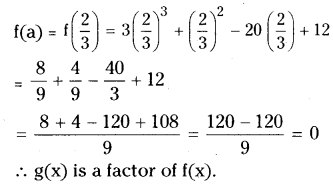
v) f(x) = 4x3+ 20x2+ 33x + 18; g(x) = 2x + 3
Solution:
g(x) = 2x + 3 = x + 3/2 = = x - a
∴ a = -3/2
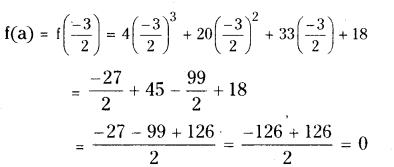
∴ g(x) is a factor of f(x).
Question 3.
Show that (x - 2), (x + 3) and (x - 4) are factors of x3- 3x2- 10x + 24.
Solution:
Given f(x) = x3- 3x2- 10x + 24
To check whether (x - 2), (x + 3) and (x - 4) are factors of f(x), let f(2), f(- 3) and f(4)
f(2) = 23- 3(2)2- 10(2) + 24
= 8- 12-20 + 24 = 0
∴ (x - 2) is a factor of f(x).
f(- 3) = (- 3)3- 3(- 3)2- 10(- 3) + 24
= - 27 - 27 + 30 + 24 = 0
∴ (x + 3) is a factor of f(x).
f(4) = (4)3- 3 (4)2- 10 (4) + 24
= 64 - 48 - 40 + 24
= 88 - 88
= 0
∴ (x - 4) is a factor of f(x).
Question 4.
Show that (x + 4), (x – 3) and (x – 7) are factors of x3 – 6x2 – 19x + 84.
Solution:
Let f(x) = x3- 6x2- 19x + 84
To verify whether (x + 4), (x - 3) and (x - 7) are factors of f(x) we use factor theorem.
Let f(- 4), f(3) and f(7)
f(- 4) = (- 4)3- 6 (- 4)2- 19 (- 4) + 84
= -64 - 96 + 76 + 84
= 0 .
∴ (x + 4) is a factor of f(x).
f(3) = 33- 6(3)2- 19(3) + 84
= 27 - 54 - 57 + 84
= 0
∴ (x - 3) is a factor of f(x).
f(7) = 73- 6(7)2- 19(7) + 84
= 343 - 294 - 133 + 84
= 427 - 427
= 0
∴ (x - 7) is a factor of f(x).
Question 5.
If both (x - 2) and (x - 1/2)of px2+ 5x + r, show that p = r.
Solution:
Let f(x) = px2+ 5x + r
As (x - 2) and (x - 1/2)are factor of f(x), we have f(2) = 0 and f(1/2) = 0
∴ f(2) = p(2)2+ 5(2) + r
= 4p + 10 + r = 0
= 4p + r
= -10 ………………(1)

⇒ p + 10 + 4r = 0
⇒ p + 4r = - 10 ………………. (2)
From (1) and (2);
4p + r = p + 4r
4p - p = 4r - r
3p = 3r
∴ P = r
Question 6.
If (x2- 1) is a factor of ax4+ bx3+ cx2+ dx + e, show that a + c + e = b + d = 0.
Solution:
Let f(x) = ax4+ bx3+ cx2+ dx + e
As (x - 1) is a factor of f(x) we have
x2- 1 = (x + 1) (x - 1) hence f(1) = 0 and f(-1) = 0
f(1) = a + b + c + d + e = 0 ……………. (1)
and f(-1) = a- b + c- d + e = 0
⇒ a + c + e = b + d
Substitute this value in equation (1)
a + c + e + b + d=0
b + d + b + d=0
2 (b + d) = 0
⇒ b + d = 0
∴ a + c + e = b + d = 0
Question 7.
Factorise
i) x3- 2x2- x + 2
Solution:
Let f(x) = x3- 2x2- x + 2
By trial, we find f(l) = 13- 2(1)2- 1 + 2
= 1 - 2 - 1 + 2
= 0 .
∴ (x - 1) is a factor of f(x).
[by factor theorem]
Now dividing f(x) by (x - 1).
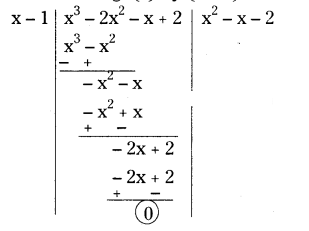
f(x) = (x - 1) (x2- x - 2)
= (x - 1) [x2- 2x + x- 2]
= (x - 1) [x (x - 2) + 1 (x - 2)]
= (x - 1) (x - 2) (x + 1)
ii) x3- 3x2- 9x - 5
Solution:
Let f(x) = x3- 3x2- 9x - 5By trial,
f(- 1) = (- 1)3- 3(- 1)2- 9(- 1) - 5
=-1 - 3 + 9 - 5
=0
∴ (x + 1) is a factor of f(x).
[ ∵ by factor theorem]
Now dividing f(x) by (x + 1).
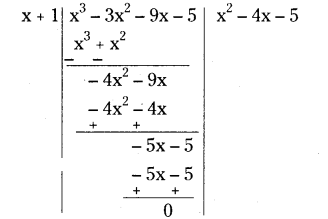
f(x)=(x + 1)(x2- 4x - 5)
But x2- 4x - 5 = x2- 5x + x - 5
= x (x - 5) + 1 (x - 5)
=(x - 5)(x + 1)
∴ f(x)=(x + 1)(x + 1)(x - 5)
iii) x3+ 13x2+ 32x + 20
Solution:
Let f(x) = x3+ 13x2+ 32x + 20
Let f(- 1)
= (- 1)3+ 13 (- 1)2+ 32 (- 1) + 20
= - 1 + 13 - 32 + 20 = 33 - 33 = 0
∴ (x + 1) is a factor of f(x).
[ ∵ by factor theorem] Now dividing f(x) by (x + 1).
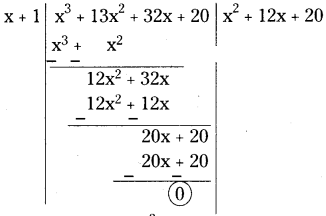
iv) y3+ y2- y - 1
Let f(y) = y3+ y2- y - 1
f(1) = 13+ 12- 1 - 1 = 0
(y - 1) is a factor of f(y).
Now dividing f(y) by (y - 1).
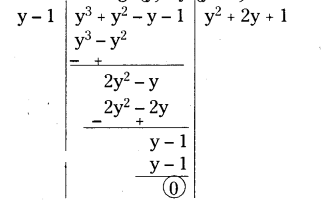
∴ f(x) = (x + 1)(x2+ 12x + 20)
But (x2+ 12x + 20) = x2+ 10x + 2x + 20
=x(x + 10)+2(x + 10)
=(x + 10)(x + 2)
∴f(x) = (x + 1)(x + 2)(x + 10)
Question 8.
If ax2+ bx + c and bx2+ ax + c have a common factor x + 1 then show that c = 0 and a = b.
Solution:
Let f(x) = ax2+ bx + c and g(x) = bx2+ ax + c given that (x + 1) is a common factor for both f(x) and g(x).
∴ f(-1) = g(- 1)
⇒a(- 1)2+ b(- 1) + c
= b(- 1)2+ a (- 1) + c
⇒ a - b + c = b - a + c
⇒ a + a = b + b
⇒ 2a = 2b
⇒ a = b
Also f(- 1) = a - b + c = 0
⇒ b - b + c = 0
⇒ c = 0
Question 9.
If x2- x - 6 and x2+ 3x - 18 have a common factor x - a then find the value of a.
Solution:
Let f(x) = x2- x - 6 and
g(x) = x2+ 3x - 18
Given that (x - a) is a factor of both f(x) and g(x).
f(a) = g(a) = 0
⇒ a2- a - 6 =a2+ 3a - 18
⇒ - 4a = - 18 + 6
⇒ - 4a = - 12
∴ a = 3
Question 10.
If (y - 3) is a factor of y3- 2y2- 9y + 18, then find the other two factors.
Solution:
Let f(y) = y3- 2y2- 9y + 18
Given that (y - 3) is a factor of f(y).
Dividing f(y) by (y - 3)
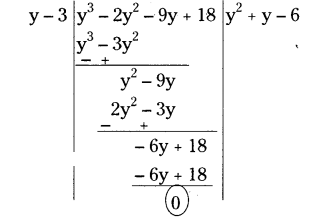
∴ f(y) = (y - 3) (y + y - 6)
But y2+ y - 6
= y2+ 3y - 2y - 6
= y (y + 3) - 2 (y + 3)
= (y + 3) (y - 2)
∴ f(y) = (y - 2)(y - 3)(y + 3)
The other two factors are (y - 2) and (y + 3).
Question 1.
Use suitable identities to find the following products.
i) (x + 5) (x + 2)
Solution:
(x + 5) (x + 2)
= x2+ (5 + 2)x + 5 x 2
[ ∵ (x + a) (x + b) = x2+ (a + b) x + ab]
= x2+ 7x + 10
ii) (x - 5) (x - 5)
Solution:
(x - 5) (x - 5)
= (x - 5)2= x2- 2(x) (5) + 52
[ ∵(x - y)2= x2- 2xy + y2]
= x2- 10x + 25
iii) (3x + 2) (3x - 2)
Solution:
(3x + 2) (3x - 2) = (3x)2- (2)2
[∵ (x + y) (x - y) =x2- y2]
= 9x2- 4
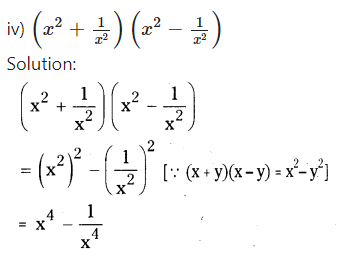
v) (1 + x) (1 + x)
Solution:
(1 + x) (1 + x)
= (1 + x)2= 12+ 2 (1) (x) + x2
[∵(x + y)2= x2+ 2xy + y2]
= 1 + 2x + x2
Question 2.
Evaluate the following products with¬out actual multiplication.
i) 101 x 99
Solution:
101 x 99
= (100 + 1) (100 - 1)
= 1002- 12
= 10000 - 1
= 9999
ii) 999 x 999
Solution:
999 x 999
= 9992
= (1000 - 1)2
= 10002- 2 x (1000) x 1 + 12
= 1000000-2000 + 1
= 998001
iii) 50 1/2 × 49 1/2
Solution:
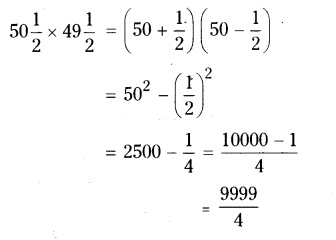
iv) 501 x 501
Solution:
501 x 501
= (500 + 1) (500 + 1)
= (500 + 1)2
= 5002+ 2 x (500) x 1 + 12
= 250000 + 1000 + 1 = 251001
v) 30.5 x 29.5 = (30 + 0.5) (30 - 0.5)
= 302- (0.5)2
= 900 - 0.25
= 899.75
Question 3.
Factorise the following using appro-priate identities.
i) 16x2+ 24xy + 9y2
Solution:
16x2+ 24xy + 9y2
= (4x)2+ 2 (4x) (3y) + (3y)2
= (4x + 3y)2= (4x + 3y) (4x + 3y)
[ ∵ (x + y)2= x2+ 2xy + y2]
ii) 4y2- 4y + 1
Solution:
4y2- 4y + 1
= (2y)2- 2 (2y) (1) + (1)2
[ ∵ (x -y)2= x2- 2xy + y2]
= (2y -1)2= (2y - 1) (2y-1)
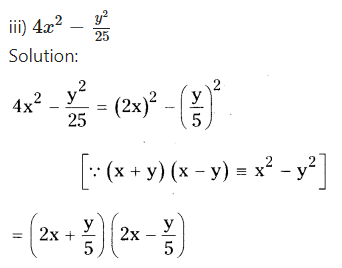
iv) 18a2- 50
Solution:
18a2- 50 = 2 (9a2- 25)
= 2[(3a)2- (5)2]
[ ∵ x2- y2= (x + y) (x - y)]
= 2 (3a + 5) (3a - 5)
v) x2+ 5x + 6
Solution:
x2+ 5x + 6 = x2+ (3 + 2) x + 3 x 2
[ ∵ (x + a) (x + b) = x2+ (a + b) x + a . b]
= (x + 3) (x + 2)
vi) 3p2- 24p + 36
Solution:
3p2- 24p + 36
= 3[p2- 8p + 12]
= 3[p2+ (- 6 - 2)p + (- 6) (- 2)]
[ ∵ (x + a) (x + b) = x2+ (a + b) x + ab]
= 3 (p - 6) (p - 2)
Question 4.
Expand each of the following, using suitable identities.
i) (x + 2y + 4z)2
(x + 2y + 4z)2= (x)2+ (2y)2+ (4z)2+ 2(x) (2y) + 2 (2y) (4z) + 2 (4z) (x)
[ ∵ (x + y + z)2= x2+ y2+ z2+ 2xy + 2yz + 2zx]
= x2+ 4y2+ 16z2+ 4xy + 16yz + 8zx
ii) (2a - 3b)3
Solution:
(2a - 3b)3= (2a)3- 3 (2a)2(3b) + 3 (2a) (3b)2- (3b)3
[ ∵ (a - b)3= a3- 3a2b + 3ab2- b3]
= 8a3- 3(4a2) (3b) + 3 (2a) (9b2) - 27b3
= 8a3- 36a2b + 54ab2-27b3
(or)
∵ (a - b)3= a3- b3- 3ab (a - b)]
= (2a)3- (3b)3- 3(2a) (3b) (2a - 3b)
= 8a3- 27b3- 18ab (2a - 3b)
iii) (- 2a + 5b - 3c)2
Solution:
(- 2a + 5b - 3c)2
= (- 2a)2+ (5b)2+ (- 3c)2+ 2 (- 2a) (5b) + 2 (5b) (- 3c) + 2 (- 3c) (- 2a)
= 4a2+ 25b2+ 9c2- 20ab - 30bc + 12ca
[ ∵ (x + y + z)2= x2+ y2+ z2+ 2xy +2yz +2za]
iv) [a/4 ? b/2 + 1]2
Solution:
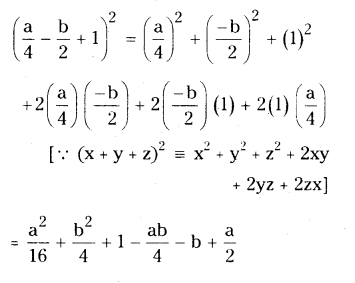
v) (p + 1)3
Solution:
(p + 1)3
= (P)3+ 3 (p)2(1) + 3 (p) (1)2+ (1)3
[ ∵ (x + y)3= x3+ 3x2y + 3xy2+ y3]
= p3+ 3p2+ 3p + 1
vi) (x ? 2/3 y)3
Solution:
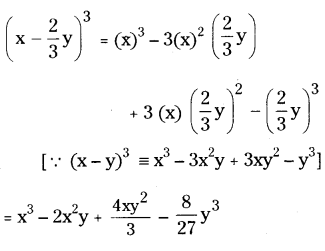
Question 5.
Factorise
i) 25x2+ 16y2+ 4z2- 40xy + 16yz - 20xz
Solution:
25x2+ 16y2+ 4z2- 40xy + 16yz - 20xz
= (5x)2+ (- 4y)2+ (- 2z)2+ 2(5x) (- 4y) + 2 (- 4y) (- 2z) + 2 (- 2z) (5x)
= (5x - 4y - 2z)2= (- 5x + 4y +, 2z)2
ii) 9a2+ 4b2+ 16c2+ 12ab - 16bc - 24ca
Solution:
9a2+ 4b2+ 16c2+ 12ab - 16bc -24ca
= (3a)2+ (2b)2+ (- 4c)2+ 2 (3a) (2b) + 2 (2b) (- 4c) + 2(- 4c) (3a)
= (3a + 2b - 4c)2
Question 6.
If a + b + c = 9 and ab + be + ca = 26, find a2+ b2+ c2.
Solution:
Given that a + b + c = 9
Squaring on both sides,
(a + b + c)2= 92
⇒ a2+ b2+ c2+ 2 (ab + be + ca) = 81 ⇒ a2+ b2+ c2= 81 - 2 (ab + be + ca)
(by problem)
= 81 - 2 x 26
= 81 - 52 = 29
Question 7.
Evaluate the following by using suit¬able identities. m EachgM)
i) (99)3
Solution:
(99)2= (100 - 1)3
= 1003- 3 (100)2(1) + 3 (100) (1)2- 13
[ ⇒ (x - y)3= x3- 3x2y + 3xy2+ y3]
= 1000000 - 30000 + 300 - 1
= 970299
ii) (102)3
Solution:
(102)3= (100 + 2)3
= 1003+ 3 (100)2(2) + 3 (100) (2)2+ 23
[ ⇒ (x + y)3= x3+ 3x2y + 3xy2+ y3]
= 1000000 + 60000 + 1200 + 8
= 1061208
iii) (998)3
Solution:
(998)3=(1000 - 2)3
[ ⇒ (x - y)3= x3- 3x2y + 3xy2- y3] = 10003- 3(1000)2(2) + 3(1000)(2)2- 23
= 1000000000 - 6000000 + 12000 - 8
= 994011992
iv) (1001)3
Solution:
(1001)3= (1000 + 1)3.
[ ⇒ (x + y)3= x3+ 3x2y + 3xy2+ y3] = 10003+ 3(1000)2(1) + 3(1000) (1)2+ 13
= 1000000000 + 3000000 + 3000 + 1
= 1003003001
Question 8.
Factorise each of the following.
i) 8a3+ b3+ 12a2b + 6ab2
Solution:
8a3+ b3+ 12a2b + 6ab2
= (2a)3+ (b)3+ 3 (2a)2(b) + 3 (2a) (b)2
= (2a + b)3
ii) 8a3- b3- 12a2b + 6ab2
Solution:
8a3- b3- 12a2b + 6ab2
= (2a)3- (b)3- 3 (2a)2(b) + 3 (2a) (b)2
= (2a - b)3
iii) 1 - 64a3-12a + 48a2
Solution:
1 - 64a3- 12a + 48a2
= (1)3- (4a)3- 3(1)2(4a) + 3(1) (4a)2
= (1 - 4a)3
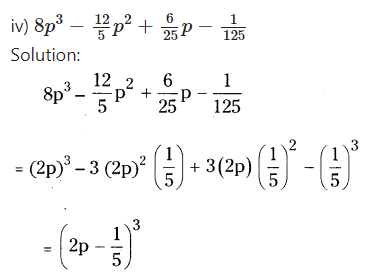
Question 9.
Verify i) x3+ y3= (x + y) (x2- xy + y2);
ii) x3- y3= (x - y) (x2+ xy + y2)
Using some non-zero positive integers and check by actual multiplication. Can you
call these as identities ?
i) x3+ y3= (x + y) (x2- xy + y2)
Solution:
Given x3+ y3= (x + y) (x2- xy + y2)
L.H.S = x3+ y3
R.H.S = (x + y) (x2- xy + y2)
= x (x2- xy + y2) + y (x2- xy + y2)
= x3-x2y + xy2+ x2y - xy2+ y3
= x3+ y3
= L.H.S
∴ L.H.S = R.H.S
Take x = 3, y = 2
L.H.S = 33+ 23= 27 + 8 = 35
R.H.S = (3 + 2) (32- 3 x 2 + 22)
= 5 x (9 - 6 + 4)
= 5 x 7 = 35
∴ L.H.S = R.H.S
ii) x3- y3= (x - y) (x2+ xy + y2)
Solution:
Given that x3- y3= (x - y) (x2+ xy + y2)
L.H.S = x3- y3
R.H.S = (x - y) (x2+ xy + y2)
= x (x2+ xy + y2) - y (x2+ xy + y2)
= x3+ x2y + xy2- x2y - xy2- y3
= x3- y3= L.H.S
L.H.S = 33- 23= 27 - 8 = 19
R.H.S = (3 - 2) (32+ 3 x 2 + 22)
= 1 x (9 + 6 + 4)
= 1 x 19 = 19
∴ L.H.S = R.H.S
We can call the above two expressions as identities
Question 10.
Factorise by using the above results (identities).
i) 27a3+ 64b3
Solution:
27a3+ 64b3= (3a)3+ (4b)3
= (3a + 4b) {(3a)2- (3a) (4b) + (4b)2}
= (3a + 4b) (9a2- 12ab + 16b2)
ii) 343y3- 1000
Solution:
343y3- 1000 = (7y)3- (10)3
= (7y - 10) [(7y)2+ (7y) (10) + (10)2]
= (7y - 10) (49y2+ 70y + 100)
Question 11.
Factorise 27x3+ y3+ z3- 9xyz using identity.
Solution:
Given 27x3+ y3+ z3- 9xyz
= (3x)3+ (y)3+ (z)3- 3 (3x) (y) (z)
= (3x + y + z)
[(3x)2+ y2+ z2- (3x) (y) - (y) (z) - (z) (3x)]
[ ⇒ (x3+ y3+ z3- 3xyz = (x + y + z) (x2+ y2+ z2- xy - yz - zx)
= (3x + y + z) (9x2+ y2+ z2- 3xy - yz - 3xz)
Question 12.
Verify that x3+ y3+ z3- 3xyz = 1/2 (x + y + z) [(x - y)2+ (y - z)2+ (z - x)2]
(OR)
Verify that
p3+ q3+ r3- 3pqr = 1/2 (p + q + r)
[(p - q)2+ (q - r)2+ (r - p)2]
Solution:
Given x3+ y3+ z3- 3xyz = 1/2 (x + y + z) [(x - y)2+ (y - z)2+ (z - x)2]
R-H.S = 1/2 (x + y + z) [(x - y)2+ (y - z)2+ (z - x)2]
= 1/2 (x + y + z) [x2+ y2- 2xy + y2+ z2- 2yz + z2+ x2- 2xz]
= 1/2 (x + y + z) [2x2+ 2y2+ 2z2- 2xy - 2yz - 2zx]
= 1/2 (x + y + z) (2) [x2+ y2+ z2- xy - yz - zx]
= (x + y + z) (x2+ y2+ z2- xy - yz - zx)
= L.H.S
Hence proved.
Question 13.
If x + y + z = 0, show that x3+ y3+ z3= 3xyz
Solution:
Given x + y + z = 0
To prove x3+ y3+ z3= 3xyz
We have an identity
(x + y + z) (x2+ y2+ z2- xy - yz - zx)
= x3+ y3+ z3- 3xyz
Substituting x + y + z = 0in the above equation, we get
0 x (x2+ y2+ z2-xy-yz-zx)
= x3+ y3+ z3- 3xyz
⇒ x3+ y3+ z3- 3xyz = 0
⇒ x3+ y3+ z3= 3xyz
Question 14.
Without actual calculating the cubes, find the value of each of the following.
i) (- 10)3+ 73+ 33
Solution:
Given (-10)3+ 73+ 33
Sum of the bases = -10 + 7 + 3 = = 0
∴ (- 10)3+ 73+ 33
= 3 (- 10) x (7) x 3
= -630
[ ∵ x + y + z = 0 then x3+ y3+ z3= 3xyz]
ii) (28)3+ (- 15)3+ (- 13)3
Solution:
Given (28)3+ (- 15)3+ (- 13)3
Sum of the bases = 28 + (- 15) + (- 13) = 0
∴ (28)3+ (- 15)3+ (- 13)3
= 3 x 28 x (- 15) x (- 13)
= 16380
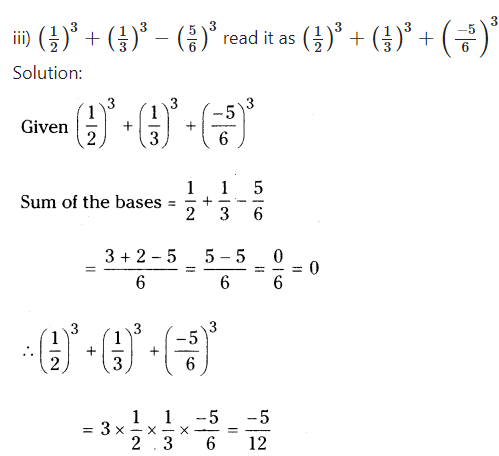
iv) (0.2)3- (0.3)3+ (0.1)3
Solution:
Given that (0.2)3- (0.3)3+ (0.1)3
= (0.2)3+ (- 0.3)3+ (0.1)3
Sum of the bases = 0.2 - 0.3 + 0.1 = 0
∴ (0.2)3+ (-0.3)3+ (0.1)3
= 3 x (0.2) (- 0.3) (0.1)
= -0.018
Question 15.
Give possible expressions for the length and breadth of the rectangle whose area is given by
i) 4a2+ 4a - 3
Given that area = 4a2+ 4a - 3
= 4a2+ 6a - 2a - 3
= 2a (2a + 3) - 1 (2a + 3)
= (2a - 1) (2a + 3)
∴ Length = (2a + 3); breadth = (2a - 1).
ii) 25a2- 35a + 12
Solution:
Given that area = 25a2- 35a +12
= 25a2- 20a - 15a + 12
= 5a (5a - 4) - 3 (5a - 4)
= (5a – 4) (5a - 3)
∴ (5a - 4) (5a - 3) are the length and breadth.
Question 16.
What are the possible polynomial expressions for the dimensions of the cuboids whose volumes are given below ?
i) 3x3- 12x
Solution:
Volume = 3x3- 12x
= 3x (x2- 4)
= 3x (x + 2) (x - 2) are the dimensions.
ii) 12y2+ 8y - 20
Solution:
Given that volume = 12y2+ 8y - 20
= 4 (3y2+ 2y - 5)
= 4 [3y2+ 5y - 3y - 5]
= 4 [y (3y + 5) - 1 (3y + 5)]
= 4 (3y + 5) (y - 1)
Hence 4, (3y + 5) and (y - 1) are the dimensions.
Question 17.
Show that if 2 (a2+ b2) = (a + b)2then a = b
Solution:
Given that 2 (a2+ b2) = (a + b)2
To prove a = b
As 2 (a2+ b2) = (a + b)2
We have
2a2+ 2b2= a2+ 2ab + b2
2a2- a2+ 2b2- b2= 2ab
a2+ b2= 2ab
This is possible only when a = b
∴ a = b